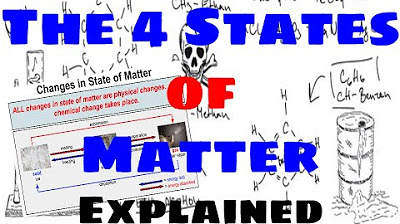Bab 2 Zat dan Perubahannya #2 (Perubahan Wujud Zat) | IPA SMP Kelas 7 | Sekolah Penggerak
Summary
TLDRThis educational video focuses on the changes in the states of matter, specifically melting, freezing, evaporation, condensation, sublimation, and crystallization. It explains how particles behave during these changes and provides real-life examples like ice turning to water and water boiling into steam. The video also discusses the concepts of melting and freezing points, as well as boiling and condensation points, using diagrams and explanations about heat energy and temperature. Engaging and relatable examples, like the use of ice in drinks and the sublimation of dry ice, make the content easy to understand and memorable for students.
Takeaways
- 😀 Changes in the state of matter can occur when heat energy is either absorbed or released.
- 😀 Solid particles are closely packed with strong bonds, and heating them causes the particles to vibrate faster, eventually breaking the bonds and turning the solid into a liquid (melting).
- 😀 Freezing occurs when a liquid loses heat energy, causing particles to slow down and form stronger bonds, turning the liquid into a solid.
- 😀 Evaporation happens at the surface of a liquid, while boiling occurs throughout the liquid, both processes involve liquid turning into gas due to heat energy.
- 😀 Particles in a liquid vibrate faster and move farther apart when heated, turning the liquid into a gas (evaporation or boiling).
- 😀 Condensation is the opposite of evaporation, where a gas loses heat energy and turns back into a liquid, often observed as dew on leaves.
- 😀 Sublimation occurs when a solid changes directly into a gas without becoming a liquid, such as with dry ice or camphor.
- 😀 Crystallization happens when a gas changes directly into a solid, such as when snowflakes form or soot accumulates on a vehicle exhaust.
- 😀 The freezing point and melting point of a substance are the same temperature. For water, both are 0°C.
- 😀 The boiling point of water is 100°C, where it transitions from liquid to gas, and this process does not involve a temperature change during boiling.
Q & A
What are the main types of phase changes discussed in the video?
-The main types of phase changes discussed are melting (or fusion), freezing, evaporation, condensation, sublimation, and crystallization.
What happens to particles in a solid when it is heated?
-When a solid is heated, the particles vibrate faster, creating more space between them, which weakens the forces between the particles. This can lead to the solid changing into a liquid.
What is the process called when a solid turns into a liquid?
-The process is called melting or fusion.
How does the process of freezing occur?
-Freezing occurs when a liquid loses heat and its particles move slower and get closer together, forming stronger bonds until they cannot move anymore, changing the substance into a solid.
What is the difference between evaporation and boiling?
-Evaporation happens only at the surface of a liquid and can occur at any temperature, while boiling happens throughout the entire liquid at a specific temperature and pressure, forming bubbles that rise to the surface.
What happens during the process of condensation?
-Condensation occurs when gas loses heat and its particles slow down, causing them to come together and form liquid. This can be observed, for example, as dew on plants in the morning.
What is sublimation, and can you give an example?
-Sublimation is the process where a solid turns directly into a gas without passing through the liquid phase. An example of sublimation is dry ice (solid carbon dioxide) turning directly into gas.
What is crystallization, and how does it occur?
-Crystallization is the process where a gas changes directly into a solid. It can be observed when substances like snow form in cold weather or when soot accumulates on a car's exhaust pipe.
What is the significance of the melting point and boiling point of a substance?
-The melting point is the temperature at which a solid turns into a liquid, while the boiling point is the temperature at which a liquid turns into a gas. Both points are critical in understanding how different substances change their states.
Why does the temperature remain constant during a phase change, even though heat is being applied?
-During a phase change, such as melting or boiling, the heat energy is used to break the bonds between particles rather than increasing the temperature. This is why the temperature remains constant until the phase change is complete.
Outlines

This section is available to paid users only. Please upgrade to access this part.
Upgrade NowMindmap

This section is available to paid users only. Please upgrade to access this part.
Upgrade NowKeywords

This section is available to paid users only. Please upgrade to access this part.
Upgrade NowHighlights

This section is available to paid users only. Please upgrade to access this part.
Upgrade NowTranscripts

This section is available to paid users only. Please upgrade to access this part.
Upgrade NowBrowse More Related Video

Kurikulum Merdeka IPA Kelas 7 Bab 2 Zat dan Perubahannya

Wujud Zat dan Perubahannya | IPAS Kelas 4 Kurikulum Merdeka

Science 8 - Quarter 3 Week 3-4 | Phase Changes

CHANGES IN STATES OF MATTER || FREEZING, MELTING, CONDENSATION, EVAPORATION, SUBLIMATION, DEPOSITION

The Four States of Matter - Explained

Grade 9 Chemistry Lesson 1 - Matter and the Particle Theory
5.0 / 5 (0 votes)